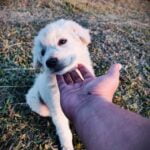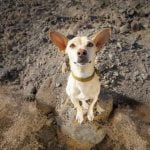Do you want to learn how to train your dog not to sniff while walking? It can be challenging to enjoy a pleasant walk with your furry companion when they constantly stop to sniff around. In this article, we will explore the importance of leash manners and why controlling your dog’s sniffing behavior is essential for a pleasant walking experience.
Understanding the natural instincts of dogs is paramount in effectively training them not to sniff excessively while on a walk. While sniffing is a natural behavior for dogs, it can disrupt the flow of a walk and make it difficult for both the owner and the pet.
We will discuss the science behind why dogs naturally sniff while walking and how it can be instinctual behavior. Additionally, we will explore leash training fundamentals and provide practical positive reinforcement techniques, as well as strategies for redirecting your dog’s attention when they are tempted to stop and sniff. With consistency and patience, you can teach your dog proper leash manners and have enjoyable walks together. Stay tuned for valuable tips and exercises on how to achieve this.
The Science Behind Sniffing
The act of sniffing is a natural behavior for dogs and serves as a way for them to gather information about their environment. When walking, dogs use their sense of smell to explore and understand the world around them. This behavior is rooted in their instinctual need to investigate scents, mark territory, and communicate with other animals.
Understanding why dogs naturally sniff while walking is crucial when it comes to training them not to do so. By recognizing that this behavior is ingrained in their nature, dog owners can approach training with patience and empathy. It’s important to remember that while it may be frustrating when a dog stops to sniff every few seconds during a walk, it’s a normal part of their canine instincts.
In order to train your dog not to sniff while walking, it’s essential to implement proper leash training techniques along with positive reinforcement methods. These strategies will help redirect your dog’s attention towards walking rather than stopping to sniff every scent they encounter. By using rewards and consistent training practices, you can guide your dog towards developing better leash manners.
Leash Training Fundamentals
Understanding Leash Training Basics
Leash training is an essential part of teaching your dog proper walking etiquette. Before addressing the specific issue of sniffing while walking, it’s crucial to establish a strong foundation in leash training. This includes teaching your dog how to walk calmly on a leash without pulling or tugging. By mastering basic leash manners, you can set the stage for more advanced training techniques to address behaviors such as excessive sniffing.
Setting Expectations and Boundaries
When starting leash training, it’s important to establish clear expectations and boundaries for your dog. This includes teaching them to walk beside you rather than forging ahead or lagging behind. Consistency is key when enforcing these expectations, as it helps your dog understand what behavior is acceptable while on a walk. By setting clear boundaries from the start, you can lay the groundwork for addressing the specific issue of sniffing during walks.
Building Trust and Communication
Leash training also provides an opportunity to build trust and improve communication with your dog. By using positive reinforcement techniques and offering rewards for good behavior, you can create a positive association with walking on a leash.
This will make it easier to introduce more advanced training methods, including those aimed at minimizing sniffing behavior while walking. Building a strong bond with your dog through effective leash training will ultimately make it easier to address any unwanted behaviors during walks, including excessive sniffing.
Positive Reinforcement Techniques
One effective positive reinforcement technique is to use treats or favorite toys as a motivator for good behavior. When your dog walks without stopping to sniff, offer a treat or engage in play as a reward. This creates a positive association between walking and receiving rewards, encouraging your dog to focus on the activity instead of getting distracted by scents along the way.
Another important aspect of positive reinforcement is timing. It’s crucial to deliver the reward immediately after your dog exhibits the desired behavior. This helps your dog make the connection between their actions and the rewards they receive, reinforcing the behavior you want to encourage.
Consistency is also key when using positive reinforcement techniques. Be sure to consistently reward your dog for maintaining good walking behavior and withhold rewards when they stop to sniff. Over time, this will help your dog understand that focusing on walking rather than sniffing is what earns them rewards.
As with any training method, patience and persistence are essential. Consistently applying positive reinforcement techniques and being mindful of your timing can help train your dog not to sniff while walking effectively.
| Positive Reinforcement Techniques | Benefits |
|---|---|
| Use treats or favorite toys as motivators | Creates positive association with walking |
| Deliver rewards immediately after desired behavior | Reinforces the connection between action and reward |
| Consistently reward good behavior and withhold rewards for unwanted behavior | Helps establish clear expectations for your dog |
Distraction and Redirecting
When it comes to leash training your dog, distraction and redirecting are crucial strategies to prevent them from constantly stopping to sniff while walking. Here are some effective techniques to implement when your furry friend becomes tempted to indulge in their natural instincts:
- Use treats: Carry a handful of your dog’s favorite treats during walks. When you notice them starting to sniff or veer off track, use the treats as a way to redirect their attention back to walking by offering a treat and using positive reinforcement.
- Engage in interactive play: Bringing along a toy or engaging in quick play sessions during the walk can help shift your dog’s focus away from sniffing. Tossing a ball or engaging in an impromptu game of tug-of-war can provide mental stimulation and redirect their attention.
- Change direction: If your dog is fixated on something that tempts them to stray from the path, simply change direction and begin walking the opposite way. This can help break their focus on the sniff-worthy distraction and refocus their attention on the walk itself.
Remember, consistency is key when implementing these distraction and redirecting techniques. Practice these methods regularly during walks, gradually reinforcing the desired behavior over time.
By incorporating these strategies into your training routine, you can effectively teach your dog not to sniff excessively while walking and foster better leash manners for enjoyable strolls together. Patience, positive reinforcement, and consistent practice will ultimately lead to success in achieving this training goal.
Consistency Is Key
Consistency is vital when it comes to training your dog not to sniff while walking. Dogs thrive on routine and structure, and maintaining consistency in your training approach will greatly increase the chances of success. By reinforcing good walking behavior consistently, you can teach your dog to focus on walking rather than sniffing, leading to more pleasant and controlled walks.
Here are some key tips for maintaining consistency in your training:
- Set clear expectations: Clearly communicate to your dog what behaviors are acceptable and what is not. Consistency in your expectations will help your dog understand what is required of them during walks.
- Establish a regular walking schedule: Dogs benefit from having a consistent routine, so aim to walk your dog at the same times each day. This will help reinforce good walking behavior over time.
- Use consistent cues and commands: Whether you use verbal cues or hand signals, be consistent in the commands you use during walks. This will help your dog understand what is expected of them and create a predictable environment for learning.
In addition to these tips, it’s essential to remain patient and persistent in your training efforts. Remember that every dog learns at their own pace, so consistency is crucial for long-term success.
By maintaining a structured routine and consistently reinforcing positive walking behavior, you can effectively train your dog not to sniff while walking.
Overall, by prioritizing consistency in your training approach and being patient with your pet, you can help them develop good leash manners and enjoy more enjoyable walks together. With time and dedication, you’ll likely notice improvements in their behavior as they learn to focus on walking rather than giving in to their natural instinct to sniff everything they encounter.
Practical Training Exercises
Training your dog not to sniff while walking can be a challenging but ultimately rewarding endeavor. By implementing specific training exercises and drills, you can help your furry companion overcome the urge to stop and sniff every few steps. It’s important to remember that patience, consistency, and positive reinforcement are key components of successful training.
One effective exercise to discourage sniffing behavior is the “leave it” command. Start by holding a treat in your closed fist and allowing your dog to sniff and paw at it. When they lose interest and back away, immediately say “leave it” and reward them with a different treat from your other hand.
Repeat this exercise several times each day, gradually increasing the difficulty by using more tempting items or treats. This will teach your dog impulse control and help them focus on walking rather than sniffing.
Another practical training exercise involves teaching your dog to maintain eye contact while walking. Begin by holding a treat at eye level and slowly walking forward. Encourage your dog to follow the treat with their gaze, rewarding them for maintaining eye contact as you walk together. Over time, this exercise will help redirect their attention from sniffing to staying focused on you while walking.
Additionally, incorporating obedience training into your walks can also be beneficial in preventing excessive sniffing. Practice basic commands such as sit, stay, and heel during your walks, rewarding your dog for following these commands without getting distracted by scents along the way. This will help reinforce their focus on you as their leader during walks.
By consistently practicing these training exercises and incorporating them into your daily walks, you can help teach your dog not to sniff excessively while walking. Remember to remain patient and provide plenty of positive reinforcement to encourage good leash manners.
Overall, training your dog not to sniff while walking requires dedication and perseverance. However, with the right techniques and consistent practice, you can enjoy pleasant walks together without constant stops for sniffing every few steps.
Troubleshooting
Distraction Techniques
One common challenge when training your dog not to sniff while walking is finding effective distraction techniques. It’s natural for dogs to be curious and want to explore their surroundings through sniffing, so it’s important to provide an alternative focus. One effective technique is to carry treats or a favorite toy with you during walks.
When you notice your dog becoming distracted by a scent, use the treat or toy to redirect their attention back to walking with you. This can help reinforce the idea that staying focused on walking and ignoring scents is rewarding.
Desensitization Training
For some dogs, the urge to sniff while walking can be particularly strong, especially if they have a heightened sense of smell. In these cases, desensitization training can be beneficial. This involves gradually exposing your dog to different scents in controlled environments and teaching them to ignore these smells.
Start by using less enticing scents and gradually work up to stronger ones. With patience and consistent practice, your dog can learn to resist the urge to stop and sniff while on a walk.
Seeking Professional Help
If you’re struggling with training your dog not to sniff while walking despite your best efforts, don’t hesitate to seek professional help from a certified dog trainer or behaviorist. They can assess your dog’s behavior and provide tailored guidance and support based on their specific needs. A professional trainer may also be able to identify underlying reasons for excessive sniffing behavior and offer targeted solutions that are personalized for your dog.
By addressing common challenges such as distractions, desensitization, and seeking professional help when needed, you can overcome obstacles in training your dog not to sniff while walking. These strategies will help you create an enjoyable walking experience for both you and your furry companion.
Conclusion
In conclusion, training your dog not to sniff while walking is an essential aspect of leash manners that can greatly enhance the overall walking experience for both you and your furry companion. By understanding the natural instinct of dogs to sniff and implementing positive reinforcement techniques, distraction and redirecting strategies, consistency, and practical training exercises, you can effectively teach your dog to focus on walking rather than stopping to investigate every scent.
By consistently practicing these training methods, you can encourage good walking behavior in your dog and create a pleasant and enjoyable walking routine for both of you. This will not only promote physical exercise and mental stimulation but also improve the bond between you and your pet. With patience, dedication, and the right approach, it is entirely possible to train your dog not to sniff while walking.
Ultimately, teaching proper leash manners will not only benefit your pet but also contribute to a more enjoyable and stress-free walking experience for you as well. By investing time in training your dog to walk without constantly stopping to sniff, you are setting the foundation for a lifetime of happy walks together. With consistent practice and positive reinforcement, you can achieve success in teaching your dog proper leash manners and enjoy the rewards of a well-behaved walking companion.
Frequently Asked Questions
How Do I Stop My Dog Sniffing Everything on a Walk?
To stop your dog from sniffing everything on a walk, you can try using a “heel” command to keep them by your side, or use positive reinforcement to reward them when they stay focused on the walk.
Should You Let Your Dog Sniff While Walking?
Allowing your dog to sniff while walking can be beneficial for their mental stimulation and overall well-being. It allows them to explore their environment and experience the world through their sense of smell.
Why Is My Dog Obsessed With Sniffing?
Dogs are obsessed with sniffing because it’s their primary way of gathering information about the world around them. Their sense of smell is incredibly powerful, and sniffing allows them to learn about other animals, people, and even potential dangers in their environment.

Welcome to the blog! I am a professional dog trainer and have been working with dogs for many years. In this blog, I will be discussing various topics related to dog training, including tips, tricks, and advice. I hope you find this information helpful and informative. Thanks for reading!





